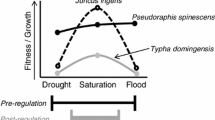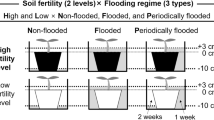Abstract
Flooding regimes are a primary influence on the wetland plant community. Human-induced disturbance often changes the duration and frequency of flooding in wetlands, and has a marked influence on wetland plant composition and viability. Comprehensive studies of the environmental thresholds of wetland plants are required for the development of proper practices for wetland management and restoration after hydrological disturbance. This study provides a quantitative assessment of the establishment, growth, and community shifts in dominance of three emergent plant species (Scirpus tabernaemontani, Typha orientalis, and Zizania latifolia) typical of South Korean wetlands, under five hydrological regimes (waterlogged, low-level standing water, high-level standing water, intensive periodic flooding, and intermittent flooding) over four growing seasons. A mesocosm experiment was conducted in the campus of Seoul National University, South Korea. The number and biomass of shoots of Z. latifolia responded positively to increased water level and flooding frequency, while that of the other plants did not. Zizania latifolia outcompeted S. tabernaemontani and T. orientalis irrespective of hydrological regime. This study suggests that Z. latifolia can outcompete the other two macrophytes in the field. This study will improve our ability to predict the dynamics of wetland vegetation and so facilitate the formulation of wetland management and restoration strategies.







Similar content being viewed by others
References
Abbas AM, Lambert AM, Rubio-Casal AE, de Cires A, Figueroa EM, Castillo JM (2015) Competition from native hydrophytes reduces establishment and growth of invasive dense-flowered cordgrass (Spartina densiflora). PeerJ 3:e1260
Asaeda T, Siong K (2008) Dynamics of growth, carbon and nutrient translocation in Zizania latifolia. Ecol Eng 32:156–165
Asaeda T, Fujino T, Manatunge J (2005) Morphological adaptations of emergent plants to water flow: a case study with Typha angustifolia, Zizania latifolia and Phragmites australis. Freshw Biol 50:1991–2001
Brock MA, Nielsen BL, Crossle K (2005) Changes in biotic communities developing from freshwater wetland sediments under experimental salinity and water regimes. Freshw Biol 50:1376–1390
Byun C, Kwon GJ, Lee D, Wojdak JM, Kim JG (2008) Ecological assessment of plant succession and water quality in abandoned rice fields. J Ecol Field Biol 31:213–223
Carter MF, Grace JB (1990) Relationships between flooding tolerance, life history, and short-term competitive performance in three species of Polygonum. Am J Bot 77:381–387
Casanova MT, Brock MA (2000) How do depth, duration and frequency of flooding influence the establishment of wetland plant communities? Plant Ecol 147:237–250
Castillo JM, Fernández-Baco L, Castellanos EM, Luque CJ, FigUeroa ME, Davy AJ (2000) Lower limits of Spartina densiflora and S. maritima in a Mediterranean salt marsh determined by different ecophysiological tolerances. J Ecol 88:801–812
Castillo JM, Redondo S, Wharmby C, Figueroa ME, Luque T, Castellanos EM, Davy AJ (2005) Environmental determination of shoot height in populations of the cordgrass Spartina maritima. Estuaries 28:761–766
Cronk JK, Fennessy MS (2001) Wetland plants: biology and ecology. CRC Press, Boca Raton
Dabbs DL (1971) A study of Scirpus acutus and Scirpus validus in the Saskatchewan River delta. Can J Bot 49:143–153
Froend R, McComb A (1994) Distribution, productivity and reproductive phenology of emergent macrophytes in relation to water regimes at wetlands of south-western Australia. Mar Freshw Res 45:1491–1508
Gaudet CL, Keddy PA (1988) A comparative approach to predicting competitive ability from plant traits. Nature 334:242–243
Grace JB (1989) Effects of water depth on Typha latifolia and Typha domingensis. Am J Bot 76:762–768
Guo HB, Li SM, Peng J, Ke WD (2007) Zizania latifolia Turcz. cultivated in China. Genet Resour Crop Evol 54:1211–1217
Hong MG, Kim JG (2016) Effects of initial density, nutrient, and water level regime on the seedling survival and growth of Typha orientalis Presl. J Plant Biol 59(4):369–376
Hong MG, Heo YJ, Kim JG (2014a) The construction and management of artificial wetland using emergent macrophytes for high biomass production. J Wetl Res 16:61–72
Hong MM, Son CY, Kim JG (2014b) Effects of interspecific competition on the growth and competitiveness of five emergent macrophytes in a constructed lentic wetland. Paddy Water Environ 12:S193–S202
Hung L, Asaeda T, Fujino T, Mnaya B (2007) Inhibition of Zizania latifolia growth by Phragmites australis: an experimental study. Wetl Ecol Manag 15:105–111
Hunter RG, Combs DL, George DB (2000) Growth of softstem bulrush (Scirpus validus) in microcosms with different hydrologic regimes and media depths. Wetlands 20:15–22
Kangas PC (2003) Ecological engineering: Principles and practice. Levis, New York
Keddy PA, Ellis TH (1985) Seedling recruitment of 11 wetland plant species along a water level gradient: shared or distinct responses? Can J Bot 63:1876–1879
Kercher SM, Zedler JB (2004) Flood tolerance in wetland angiosperms: a comparison of invasive and noninvasive species. Aquat Bot 80:89–102
Kwon GJ, Lee BA, Byun CH, Nam JM, Kim JG (2006) The optimal environmental ranges for wetland plants: I. Zizania latifolia and Typha angustifolia. J Korean Soc Environ Restor Reveg Technol 9:72–88
Lee BA, Kim JG (2007) The optimal environmental ranges for wetland plants: II. Scirpus tabernaemontani and Typha latifolia. J Ecol Environ 30:151–159
Liatukas Ž, Vaclovas S (2009) Zizania latifolia—a new alienplant in Lithuania. Bot Lith 15:17–24
Magee TK, Kentula ME (2005) Response of wetland plant species to hydrologic conditions. Wetl Ecol Manag 13:163–181
Mitsch WJ, Gosselink JG (2015) Wetlands. Wiley, New Jersey
Nam JM, Cho HS, Kim JG (2015) Effect of plant life cycle on plant settlement in diverse water level. J Wetl Res 17:19–25
Newman S, Grace JB, Koebel JW (1996) Effects of nutrients and hydroperiod on Typha, Cladium, and Eleocharis: implications for Everglades restoration. Ecol Appl 6:774–783
NRC (1992) Restoration of aquatic ecosystems. National Academy Press, Washington, DC
Sharma P, Asaeda T, Fujino T (2008) Effect of water depth on the rhizome dynamics of Typha angustifolia. Wetl Ecol Manag 16:43–49
Tanner CC (1996) Plants for constructed wetland treatment systems—a comparison of the growth and nutrient uptake of eight emergent species. Ecol Eng 7:59–83
Tsuchiya T, Shinozuka A, Ikusima I (1993) Population dynamics, productivity and biomass allocation of Zizania latifolia in an aquatic-terrestrial ecotone. Ecol Res 8:193–198
van den Brink FW, van der Velde G (1995) Effects of substrate parameters on growth responses of eight helophyte species in relation to flooding. Aquat Bot 50:79–97
van der Valk AG (1981) Succession in wetland: a Gleasonian approach. Ecology 62:688–696
van der Valk AG (2005) Water-level fluctuations in North American prairie wetlands. Hydrobiologia 539:171–188
Vivian-Smith G (1997) Microtopographic heterogeneity and floristic diversity in experimental wetland communities. J Ecol 85:71–82
Voesenek LACJ, Rijnders JHGM, Peeters AJM, van de Steeg HM, de Kroon H (2004) Plant hormones regulate fast shoot elongation under water: from genes to communities. Ecology 85:16–27
Wetzel P, van der Valk A (1998) Effects of nutrient and soil moisture on competition between Carex stricta, Phalaris arundinacea, and Typha latifolia. Plant Ecol 138:179–190
Wisheu IC, Keddy PA (1992) Competition and centrifugal organization of plant communities: theory and tests. J Veg Sci 3:147–156
Yamasaki S (1984) Role of plant aeration in zonation of Zizania latifolia and Phragmites australis. Aquat Bot 18:287–297
Yamasaki S, Tange I (1981) Growth responses of Zizania latifolia, Phragmites australis and Miscanthus sacchariflorus to varying inundation. Aquat Bot 10:229–239
Acknowledgement
The Basic Science Research Program, through the National Research Foundation of Korea (NRF) and funded by the Ministry of Education (NRF-2015R1D1A1A01057373), and BrainKorea21 Plus project provided support to Jae Geun Kim. The Basic Science Research Program, through the NRF and funded by the Ministry of Education (2015R1A6A3A01058185), provided support to Chaeho Byun.
Author information
Authors and Affiliations
Corresponding author
Additional information
Communicated by Julie C. Zinnert.
Chaeho Byun and Jong Min Nam have contributed equally to this work.
Rights and permissions
About this article
Cite this article
Byun, C., Nam, J.M. & Kim, J.G. Effects of flooding regime on wetland plant growth and species dominance in a mesocosm experiment. Plant Ecol 218, 517–527 (2017). https://doi.org/10.1007/s11258-017-0707-0
Received:
Accepted:
Published:
Issue Date:
DOI: https://doi.org/10.1007/s11258-017-0707-0




